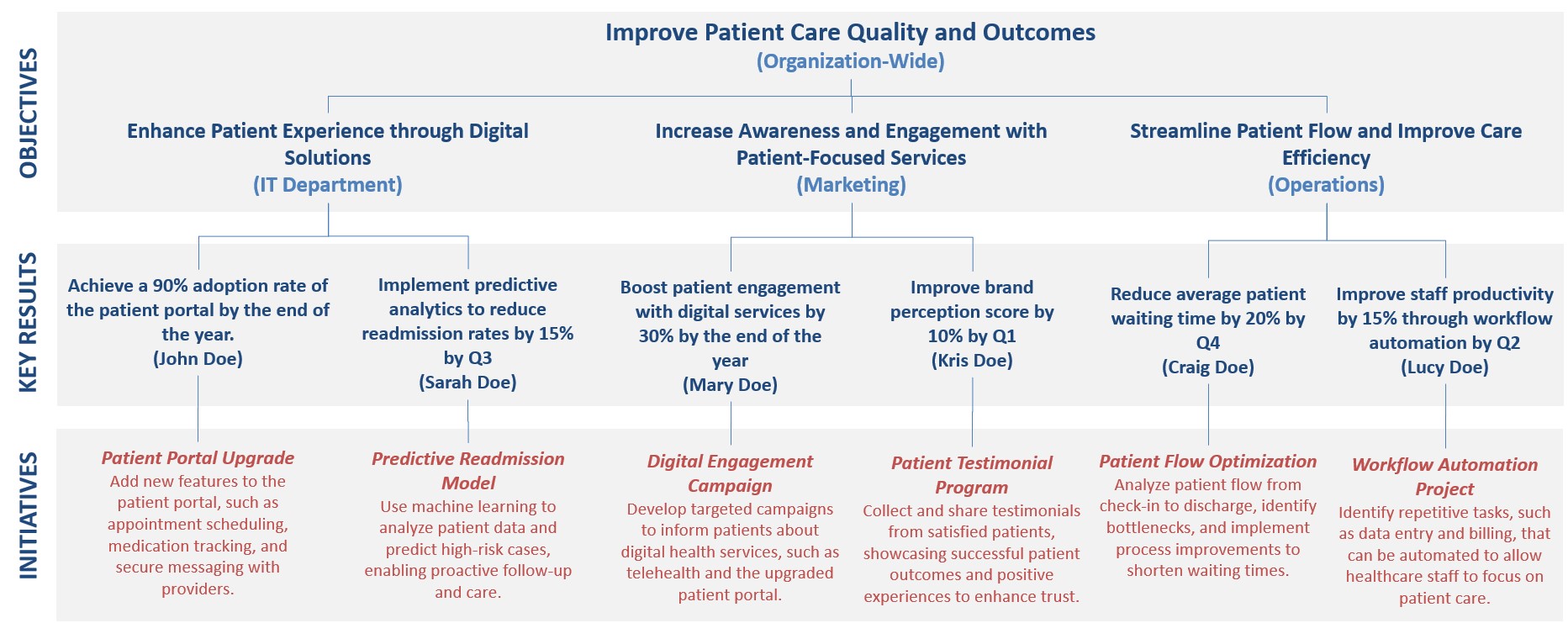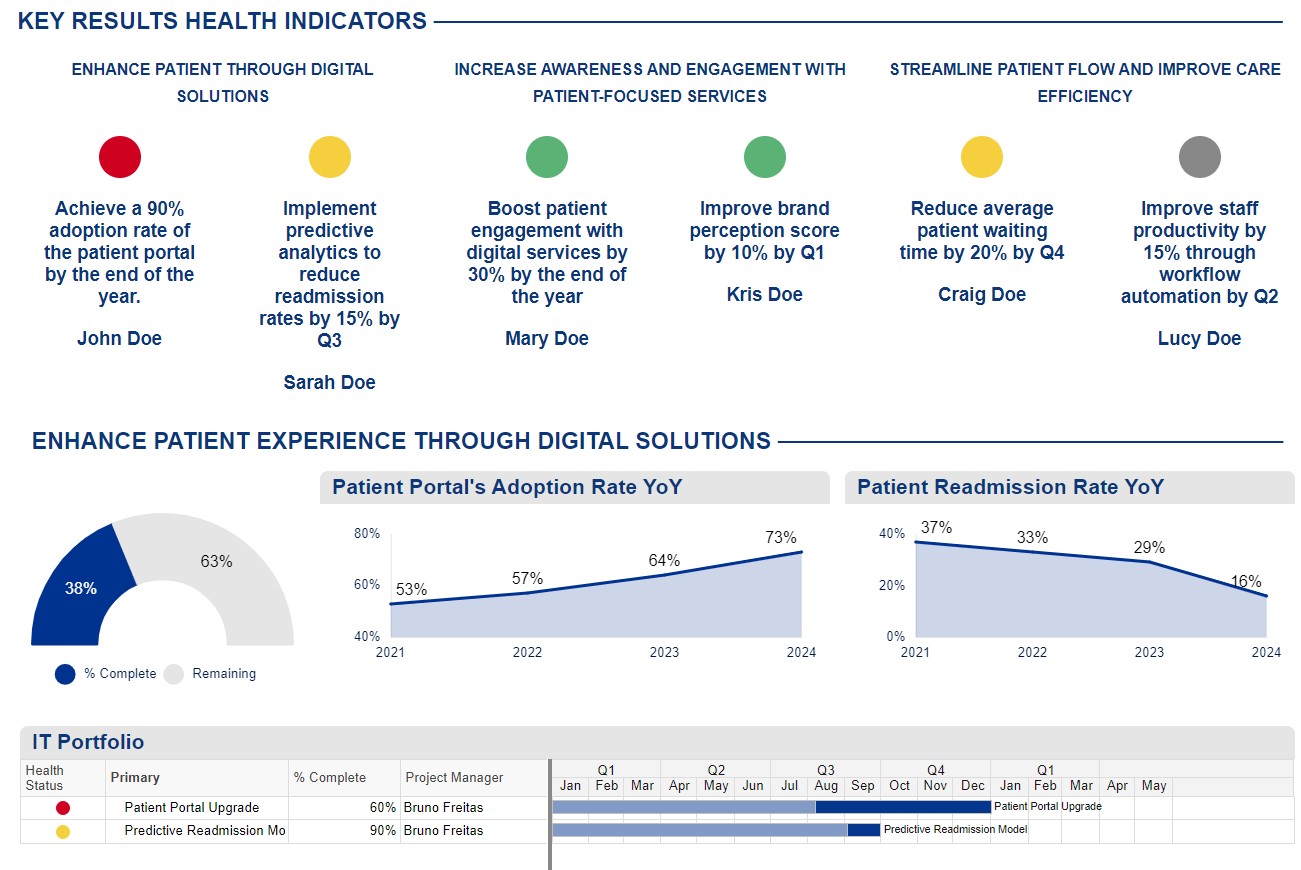In today’s fast-paced business environment, aligning strategic goals with day-to-day execution remains a significant challenge for many organizations. Despite well-articulated strategies, translating these into measurable actions is often where execution falters. In this blog post, I’ll explore how Objectives and Key Results (OKRs) can effectively bridge this gap, driving focus, alignment, and accountability. This approach not only enhances transparency but also ensures that every project within the organization contributes meaningfully to strategic objectives.
(By the way, this was a topic of my recent conversation with the PMI Northern Alberta Chapter’s Community of Practice group. You can download the slide deck from our Resources Page)
Understanding OKRs: A Brief Overview
The OKR framework stands for Objectives and Key Results:
-
Objectives are qualitative, clear statements of what you want to achieve. They should be inspirational and aligned with broader organizational goals.
-
Key Results are the measurable outcomes used to track progress towards the objective. They should be quantitative, time-bound, and designed to challenge but remain attainable.
The core purpose of OKRs is to streamline goal-setting, drive focus, and establish a clear connection between strategy and execution. By implementing OKRs, organizations can ensure that every project is aligned with their strategic priorities, thus maximizing value.
The Origins of OKRs: A Proven Success Story
The concept of OKRs was first introduced by Andy Grove at Intel in the 1970s. Grove evolved Peter Drucker’s Management by Objectives (MBO) framework into something more actionable and aimed at fostering accountability across all levels of the organization. At Intel, the focus was on shifting from memory chips to microprocessors—a critical and highly competitive pivot at the time. This strategic focus helped Intel achieve significant milestones in its business evolution.
Google later adopted OKRs when it was still a startup, with fewer than 50 employees. The company aimed to foster innovation and agility in its fast-paced environment by setting quarterly OKRs with a stretch goal mindset (achievable at around 70-80%). By normalizing “falling short” as a sign of ambition, Google effectively embedded a culture of continuous improvement.
Today, many leading organizations, including Amazon, LinkedIn, and Dropbox, use OKRs to align strategy with projects and track progress towards achieving key goals.
Why Use OKRs?
The benefits of implementing OKRs are substantial:
-
Enhanced Focus and Clarity: By defining clear objectives, teams know exactly what the organization aims to achieve.
-
Alignment Across Teams: OKRs ensure that every project and initiative is linked back to broader strategic goals.
-
Improved Transparency: The visibility of OKRs at all levels of the organization fosters a culture of openness and shared accountability.
-
Outcome-Oriented Mindset: OKRs shift the focus from output (tasks completed) to outcomes (meaningful results achieved).
Common Pitfalls in OKR Implementation
While OKRs can be transformative, many organizations struggle with their implementation. I have encountered the following common issues:
-
Generic and Vague Objectives: Objectives like “Improve patient care” or “Enhance customer satisfaction” are often too broad and lack specificity. Effective objectives should be clear, targeted, and inspirational.
-
Lack of Measurable Key Results: Without clear metrics, it’s difficult to gauge progress. Key Results must be quantitative and time-bound, such as “Achieve a 90% adoption rate of the patient portal by the end of the year.”
-
Absence of Accountability: Assigning specific owners to each Key Result is crucial. Without clear accountability, the likelihood of achieving the desired outcomes diminishes.
See below an example of a poorly defined strategy for a hypothetical healthcare provider:

Can you figure the issues with these OKRs? Not measurable, vaguely defined, you can almost fit any project under them and so on.
A Practical Example: Healthcare Provider
Let’s dive into a practical example that illustrates the effective use of OKRs in a healthcare setting.
Objective: Improve Patient Care Quality and Outcomes (Organization-Wide)
-
IT Department Objective: Enhance Patient Experience through Digital Solutions
-
Key Result 1: Achieve a 90% adoption rate of the patient portal by the end of the year (John Doe).
-
Key Result 2: Implement predictive analytics to reduce readmission rates by 15% by Q3 (Sarah Doe).
-
-
Marketing Department Objective: Increase Awareness and Engagement with Patient-Focused Services
-
Key Result 1: Boost patient engagement with digital services by 30% by the end of the year (Mary Doe).
-
Key Result 2: Improve brand perception score by 10% by Q1 (Kris Doe).
-
-
Operations Department Objective: Streamline Patient Flow and Improve Care Efficiency
-
Key Result 1: Reduce average patient waiting time by 20% by Q4 (Craig Doe).
-
Key Result 2: Improve staff productivity by 15% through workflow automation by Q2 (Lucy Doe).
-
This example demonstrates how specific, measurable Key Results are linked to broader organizational goals, ensuring clear accountability and a focused path to achieving strategic objectives. With clear key results defined, they can be an ally to your project selection process. If any proposed project is not going to effectively contribute to the achievement of your key results, then the project should not be pursued. In the picture below, it is easy to map the objectives, key results and portfolio of projects for the entire organization, which significantly increases transparency on what the company should be focusing on and why:

The OKR Cycle
The typical OKR cycle includes the following stages:
-
Planning and Setting OKRs: This is the stage where leadership defines the strategic objectives and key results. It is crucial to engage multiple layers of the organization in this process to ensure that the OKRs are realistic and aligned across teams.
-
Mid-Cycle Review: Midway through the cycle, a review is conducted to assess progress. This stage allows teams to pivot or make adjustments if necessary.
-
End-of-Cycle Review: At the end of the cycle, the results are evaluated. This review is an opportunity for reflection, learning, and adjusting strategies for the next cycle.
Tracking OKRs with Smartsheet
One of the effective ways to track OKRs is by using a tool like Smartsheet (even an Excel spreadsheet works, but it can be cumbersome to maintain depending on the volume of information you need to handle and report). The platform offers robust features for setting up dashboards and visualizing progress. For instance, an OKR dashboard can provide a real-time view of health indicators for each Key Result:
-
Adoption Rate of Patient Portal: This metric can be tracked month-over-month, with a target adoption rate clearly defined. Any deviations can trigger a review and potential adjustments.
-
Staff Productivity Improvement: Workflow automation initiatives can be tracked through key metrics such as task completion rates and time savings.

Focusing on the Adoption Rate metric, for example, we have the Patient Portal Upgrade project supporting it. In this case, even if the project is green (on time, on budget etc), there might be a reason to stop it. If the project is not going to help the organization to increase the number of patients using the patient portal (ex: the portal is not user friendly or it does not bring the convenience that the patients are looking for), then you might want to review the objectives/scope of the project or stop it and reassign your resources to some other project more closely aligned with your strategic goals.
(You can download this OKR dashboard example from our Resources page as well.)
Recommendations for Implementing OKRs
Here are some actionable recommendations for organizations looking to implement OKRs:
-
Start Small: Begin by implementing OKRs at a departmental level before scaling them organization-wide.
-
Focus on Outcomes, Not Output: Ensure that your Key Results are tied to meaningful business outcomes rather than mere task completion.
-
Ensure Transparency: Make OKRs visible to all stakeholders to foster alignment and shared accountability.
-
Embrace a Mindset Shift: OKRs require a cultural shift from traditional project management towards a more agile, outcome-driven approach.
-
Regularly Review and Adjust: Use mid-cycle reviews to assess progress and make necessary pivots to stay aligned with strategic objectives.


